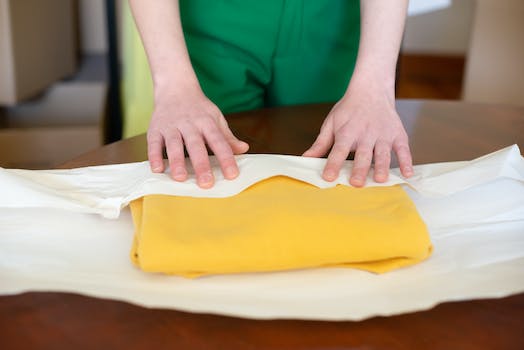How To Start A Business Selling Clothes
“From passion to profit: A beginner’s guide to launching your own clothing business.”
Introduction
Starting a business selling clothes can be a lucrative venture for those with a passion for fashion and an entrepreneurial spirit. However, it can also be a challenging and competitive industry to break into. In this guide, we will provide some tips and steps on how to start a business selling clothes, from conducting market research to creating a business plan and launching your brand.
Finding Your Niche in the Clothing Industry
Starting a business selling clothes can be a great way to turn your passion for fashion into a profitable venture. However, with so many options available in the clothing industry, it can be overwhelming to figure out where to start. One of the most important steps in starting a successful clothing business is finding your niche.
Your niche is the specific area of the clothing industry that you will focus on. It’s important to find a niche that you are passionate about and that has a demand in the market. Here are some tips to help you find your niche in the clothing industry:
1. Identify your target market
The first step in finding your niche is to identify your target market. Who are the people that you want to sell your clothes to? Are they men, women, or children? What age group do they belong to? What is their style and fashion preference? Answering these questions will help you narrow down your options and find a niche that caters to your target market.
2. Research the market
Once you have identified your target market, it’s important to research the market to see what’s already out there. Look at the competition and see what they are offering. Are there any gaps in the market that you can fill? Are there any trends that you can capitalize on? This research will help you find a unique selling point for your business.
3. Consider your skills and expertise
Another important factor to consider when finding your niche is your skills and expertise. What are you good at? Do you have any experience in a particular area of the clothing industry? For example, if you have a background in fashion design, you may want to focus on creating your own designs. If you have experience in marketing, you may want to focus on promoting and selling other designers’ clothes.
4. Think about your values and beliefs
Your values and beliefs can also play a role in finding your niche. Do you want to focus on sustainable and ethical fashion? Do you want to cater to a specific body type or size? These values and beliefs can help you find a niche that aligns with your personal brand and mission.
5. Test the market
Once you have identified your niche, it’s important to test the market before investing too much time and money into your business. Start small by selling your clothes at local markets or online. Get feedback from your customers and see what’s working and what’s not. This will help you refine your niche and make any necessary adjustments before launching your business on a larger scale.
In conclusion, finding your niche in the clothing industry is a crucial step in starting a successful business. By identifying your target market, researching the market, considering your skills and expertise, thinking about your values and beliefs, and testing the market, you can find a niche that sets you apart from the competition and resonates with your customers. Good luck on your journey to starting a clothing business!
Creating a Business Plan for Your Clothing Business

Starting a business selling clothes can be an exciting and rewarding venture. However, before you dive in headfirst, it’s important to create a solid business plan. A business plan will help you define your goals, identify your target market, and outline your strategies for success.
The first step in creating a business plan for your clothing business is to define your niche. What type of clothing will you sell? Will you focus on a specific demographic, such as women’s clothing or children’s clothing? Will you specialize in a particular style, such as vintage or bohemian? Defining your niche will help you narrow down your target market and tailor your marketing efforts accordingly.
Once you’ve defined your niche, it’s time to conduct market research. This involves gathering information about your target market, such as their age, gender, income level, and shopping habits. You can gather this information through surveys, focus groups, or by analyzing data from online sources. This information will help you understand your target market’s needs and preferences, and will inform your product development and marketing strategies.
Next, you’ll need to develop a pricing strategy. This involves determining the cost of your products, including materials, labor, and overhead, and setting a price that will allow you to make a profit. You’ll also need to consider your competition and the prices they are charging for similar products. Your pricing strategy should be competitive, but also allow you to make a profit and cover your expenses.
Another important aspect of your business plan is your marketing strategy. This involves identifying the channels you will use to reach your target market, such as social media, email marketing, or advertising. You’ll also need to develop a brand identity, including a logo, color scheme, and messaging that will resonate with your target market. Your marketing strategy should be tailored to your niche and target market, and should be designed to build brand awareness and drive sales.
Finally, you’ll need to develop a financial plan. This involves projecting your revenue and expenses for the first few years of your business, and determining how much funding you will need to get started. You’ll also need to consider your cash flow, including how you will manage your inventory and pay your bills. Your financial plan should be realistic and based on accurate projections, and should include contingency plans for unexpected expenses or changes in the market.
In conclusion, creating a business plan is an essential step in starting a business selling clothes. It will help you define your niche, conduct market research, develop a pricing strategy, create a marketing plan, and project your financials. By taking the time to create a solid business plan, you’ll be better prepared to launch your business and achieve success.
Sourcing Materials and Manufacturers for Your Clothing Line
Starting a business selling clothes can be an exciting and rewarding venture. However, it can also be overwhelming, especially when it comes to sourcing materials and manufacturers for your clothing line. In this article, we will guide you through the process of finding the right materials and manufacturers for your business.
The first step in sourcing materials for your clothing line is to determine the type of fabric you want to use. There are many different types of fabrics available, each with its own unique properties and characteristics. Some popular options include cotton, silk, wool, and polyester. Consider the style and function of your clothing line when choosing your fabric. For example, if you are creating activewear, you may want to choose a moisture-wicking fabric that is breathable and stretchy.
Once you have chosen your fabric, it’s time to find a supplier. There are many fabric suppliers available, both online and in-person. Do your research and compare prices and quality before making a decision. You may also want to consider working with a textile agent who can help you find the right fabric supplier for your needs.
In addition to fabric, you will also need to source other materials such as zippers, buttons, and thread. These materials can be found at craft stores or online suppliers. Again, do your research and compare prices and quality before making a decision.
Once you have sourced your materials, it’s time to find a manufacturer to produce your clothing line. There are many manufacturers available, both domestic and overseas. Domestic manufacturers may be more expensive, but they offer the benefit of being able to visit the factory and oversee the production process. Overseas manufacturers may be less expensive, but communication and quality control can be more challenging.
When choosing a manufacturer, consider their experience, reputation, and production capabilities. You may also want to ask for samples of their work to ensure that their quality meets your standards. It’s important to establish a good working relationship with your manufacturer and communicate clearly and regularly to ensure that your clothing line is produced to your specifications.
In addition to finding a manufacturer, you will also need to consider the logistics of shipping and importing your products. If you are working with an overseas manufacturer, you will need to factor in shipping costs and customs fees. It’s important to work with a reputable shipping company and ensure that all necessary paperwork is in order to avoid any delays or issues.
In conclusion, sourcing materials and manufacturers for your clothing line can be a daunting task, but with careful research and planning, it can be a smooth and successful process. Remember to consider the style and function of your clothing line when choosing your materials, and to establish a good working relationship with your manufacturer. With these tips in mind, you’ll be on your way to creating a successful clothing business.
Building Your Brand and Marketing Your Clothing Business
Starting a business selling clothes can be an exciting and rewarding venture. However, it can also be a daunting task, especially if you are new to the industry. Building your brand and marketing your clothing business is crucial to its success. Here are some tips to help you get started.
1. Define Your Brand
Before you start marketing your clothing business, you need to define your brand. Your brand is what sets you apart from your competitors and makes you unique. It is the personality of your business. To define your brand, you need to consider your target audience, your values, and your mission statement. Your brand should be consistent across all your marketing channels, including your website, social media, and packaging.
2. Create a Website
In today’s digital age, having a website is essential for any business. Your website is your online storefront, and it is where potential customers will go to learn more about your brand and products. Your website should be easy to navigate, visually appealing, and mobile-friendly. It should also have a clear call-to-action, such as “Shop Now” or “Sign Up for Our Newsletter.”
3. Use Social Media
Social media is a powerful tool for marketing your clothing business. It allows you to connect with your target audience and build a community around your brand. Choose the social media platforms that are most relevant to your target audience, such as Instagram, Facebook, or Pinterest. Post regularly and engage with your followers by responding to comments and messages.
4. Collaborate with Influencers
Influencer marketing is a popular way to promote your clothing business. Collaborating with influencers can help you reach a wider audience and build credibility for your brand. Look for influencers who align with your brand values and have a following that matches your target audience. You can offer them free products or pay them for their services.
5. Attend Trade Shows
Attending trade shows is a great way to network with other businesses in the fashion industry and showcase your products. Look for trade shows that are relevant to your niche and target audience. Bring samples of your products and business cards to hand out to potential customers and partners.
6. Offer Discounts and Promotions
Offering discounts and promotions is a great way to attract new customers and retain existing ones. You can offer discounts for first-time customers, bundle deals, or seasonal promotions. Make sure to promote your discounts and promotions on your website and social media channels.
7. Provide Excellent Customer Service
Providing excellent customer service is crucial to the success of your clothing business. Make sure to respond to customer inquiries and complaints promptly and professionally. Offer free returns and exchanges to ensure customer satisfaction. Happy customers are more likely to recommend your brand to others and become repeat customers.
In conclusion, building your brand and marketing your clothing business is essential to its success. Define your brand, create a website, use social media, collaborate with influencers, attend trade shows, offer discounts and promotions, and provide excellent customer service. With these tips, you can start a successful clothing business and achieve your entrepreneurial dreams.
Managing Your Finances and Scaling Your Clothing Business
Starting a business selling clothes can be an exciting and rewarding venture. However, it can also be challenging, especially when it comes to managing your finances and scaling your business. In this article, we will provide you with some tips on how to manage your finances and scale your clothing business.
Managing Your Finances
One of the most important aspects of starting a business is managing your finances. Here are some tips to help you manage your finances effectively:
1. Create a budget: A budget is a financial plan that helps you track your income and expenses. It is essential to create a budget for your clothing business to ensure that you are not overspending and that you have enough money to cover your expenses.
2. Keep track of your expenses: It is crucial to keep track of your expenses to ensure that you are not overspending. You can use accounting software or a spreadsheet to keep track of your expenses.
3. Separate your personal and business finances: It is essential to separate your personal and business finances to avoid confusion. You can open a separate bank account for your business to keep your finances organized.
4. Monitor your cash flow: Cash flow is the amount of money that comes in and goes out of your business. It is essential to monitor your cash flow to ensure that you have enough money to cover your expenses.
Scaling Your Clothing Business
Scaling your clothing business means growing your business to reach more customers and increase your revenue. Here are some tips to help you scale your clothing business:
1. Expand your product line: One way to scale your clothing business is to expand your product line. You can add new products or designs to attract more customers.
2. Increase your marketing efforts: Marketing is essential to reach more customers and increase your revenue. You can use social media, email marketing, or paid advertising to promote your clothing business.
3. Partner with other businesses: Partnering with other businesses can help you reach more customers and increase your revenue. You can collaborate with other clothing brands or fashion bloggers to promote your clothing business.
4. Hire employees: Hiring employees can help you scale your clothing business by allowing you to focus on other aspects of your business. You can hire employees to help with production, marketing, or customer service.
Conclusion
Starting a business selling clothes can be challenging, but with the right strategies, you can manage your finances and scale your business. Creating a budget, keeping track of your expenses, separating your personal and business finances, and monitoring your cash flow are essential to managing your finances effectively. Expanding your product line, increasing your marketing efforts, partnering with other businesses, and hiring employees are some of the ways to scale your clothing business. With these tips, you can take your clothing business to the next level and achieve success.
Conclusion
Starting a business selling clothes requires careful planning and research. It is important to identify your target market, choose a niche, and create a strong brand identity. You will also need to consider factors such as sourcing products, setting prices, and marketing your business. By following these steps and staying focused on your goals, you can build a successful clothing business.






